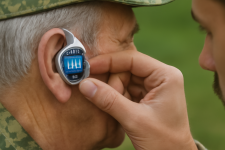
Members of the armed services put their lives on the line to protect the citizens and borders of our country. But for many, the comfort of returning home is all too often marked by another confrontation: the battle with hearing loss due to the deafening nature of modern warfare.
Over three and a half million US veterans alone have government-recognized hearing damage, including tinnitus and general hearing loss.
The lack of a more concerted treatment effort for returning soldiers marks a significant challenge in veteran affairs. Many veterans suffering from hearing loss feel an acute impact on communications with their families, their psychological health, and their ability to return to work and civilian life. Some report increased feelings of alienation and loneliness on account of hearing damage.
While there are hearing loss solutions on the market, including improved hearing aids that are available both to veterans and to the general population, hearing aids are not necessarily the solution for every person’s distinct needs. In addition, many are reluctant to embrace such solutions due to stigmas surrounding disability.
Fortunately, a brighter future for veterans with hearing damage is emerging, thanks to a new generation of assistive hearing technologies. These innovative solutions and devices, many powered by AI, are reshaping access and outcomes – not just medically, but emotionally and socially as well.
The following are some of the hearing-related challenges facing veterans and ways AI tools are helping to reinvigorate their lives.
How big is the problem, really?
Hearing loss is one of the most widespread disabilities associated with military service. Its impact is compounded by the countless other challenges of returning to civilian life.
American servicemembers begin their military service at a younger age, which leads to most experiencing hearing loss as early as their 20s, forcing them to grapple with issues that most adults don’t have to face until their later years.
Alongside the practical disadvantages of hearing loss – difficulty communicating in person or over the phone, difficulty in watching TV and films – there are numerous mental health symptoms that are strongly correlated to hearing loss for veterans. These are especially prevalent among those suffering from tinnitus, a prolonged, persistent, high-pitched ringing that arises when the inner ear has been damaged. Those who suffer from the often-maddening symptoms of tinnitus regularly report increased feelings of isolation and depression. Combined with generalized PTSD that veterans often bring home, hearing issues create a potent mix of anxiety-inducing feelings that compound the challenges servicemembers face as they seek to reenter civilian life.
As is the case among civilian hearing loss patients, veterans tend to delay seeking treatment for hearing damage. Though hearing loss and tinnitus are two of the most common injuries reported for disability compensation claims, their invisible nature and association with the natural progression of aging are just two of the things that discourage people from getting help.
Traditional hearing aids, often the starting point for most hearing loss treatments, are often viewed as not being discreet enough to appeal to younger veterans. Despite the ability of hearing aids to improve many daily experiences, a significant portion of veterans are still reluctant to use these tools because they perceive them as unsightly, embarrassing, or shameful. As a result, some veterans wait decades before being fit for such devices.
The United States Department of Veterans Affairs, commonly known as the VA, is at the fore of addressing these issues, offering support to veterans in the form of financial compensation, mental and physical health services, and more. Unfortunately, the VA remains an underutilized resource, often hampered by bureaucratic red tape. Many veterans are reluctant to lean on the VA, either because the benefits have been insufficiently advertised, because of the difficulty in navigating the bureaucracy, or the perceived costs and stigmas associated with receiving assistance.
Beyond the Hearing Aid: Increasing Access to Better Hearing Tech
While hearing aids are a useful solution, they are no longer the only option. A new wave of assistive technologies is filling the gaps.
Some are turning to widely available consumer products, such as AirPods or other wireless earbuds, which can offer effective, low-cost, accessible, stigma-free solutions to some of the basic effects of hearing loss. Some of these consumer earbuds, when paired with certain applications, can achieve similar functions to standard hearing aids. They also enable the consistent playing of music or white noise, which can help minimize the symptoms of tinnitus.
Perhaps the most significant innovations in hearing accessibility tech are coming from the advances in AI. For example, several companies, including Nagish, have leveraged innovations in artificial intelligence to create AI-powered captioning tools for phone calls, real-time transcription services, text-to-speech, and speech-to-text features in smartphones and desktop apps. These tools empower users to communicate effectively, in person, over the phone, and at the workplace, all without requiring them to disclose their hearing status, give up on privacy, or struggle through awkward moments. Some of these tools are free, smartphone-based, and even FCC-certified, making them eligible for compensation by the federal government, allowing eligible users to use these services at no cost.
Several high-profile companies like Google, Apple, and Microsoft, have already released or announced accessibility features, which speaks to the increasingly widespread recognition of the issue. Such adoption has also accelerated the integration of such features with everyday tech, such as iOS and Android systems. The incorporation of AI-powered tools into daily devices like phones, computers, and TVs is critical for overcoming the hurdles of affordability and accessibility in hearing tech.
To build a brighter future for hearing loss care for veterans and civilians alike, the first step is raising awareness that hearing loss can mean much more than just difficulty hearing. It can lead to withdrawal, depression, and a certain disconnect from community and support systems. By striving to better understand the realities of hearing loss, as well as its wider impacts, we can create accessible communication technologies that enable veterans to rebuild confidence, regain independence in communications, avoid stigmas, and seek earlier intervention.
Fortunately, hearing loss among veterans doesn’t need to mean isolation or frustration. With the rise of modern, AI-powered tech solutions for hearing loss, veterans can regain agency in their daily lives. But it’s on the rest of us to normalize assistive tech, for everyone navigating hearing challenges.
After all our veterans have sacrificed, we owe them that… and much more.
The post From Isolation to Inclusion: Empowering Veterans with Smarter Hearing Tech appeared first on Unite.AI.


